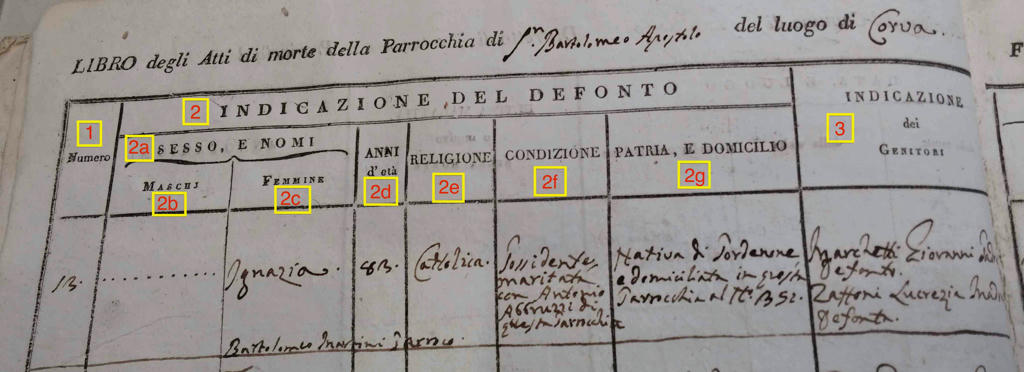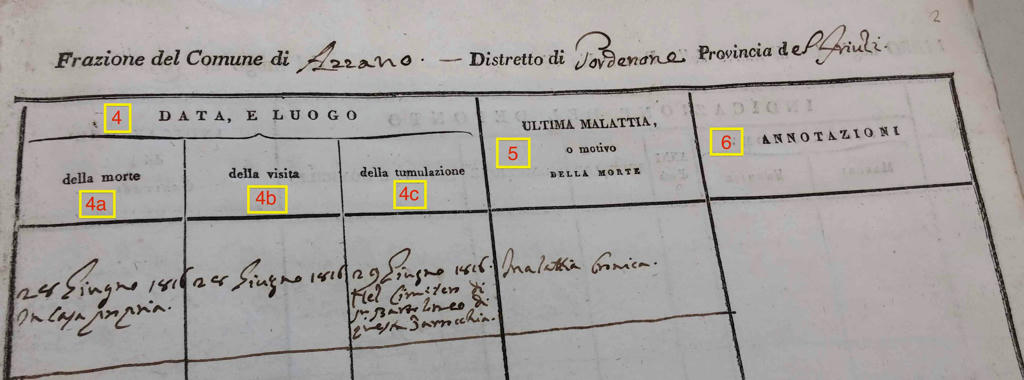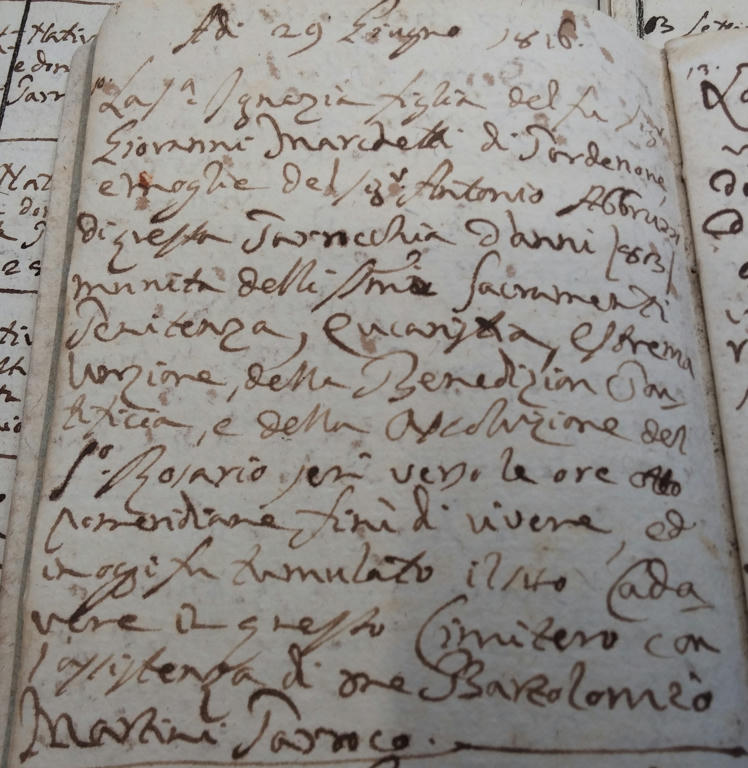Understanding 1815-1871 Civil registrations [Births] with introduction
Understanding 1815-1871 Civil registrations [Marriages]
Just as I did with the two previous posts I'm going to follow the same pattern for this last one.
The most interesting thing about these civil registrations is that they had a column for the cause of death, which is something that is rarely seen in Church books (actually, it depends on the parish and its priest, as always).
Another difference that I've often seen between these and the church registrations is that the civil ones mention, when it was known, the name of the mother (of the deceased).
I'm going to show you an example for one of my ancestors, for whom I have both the civil death registration and the burial notice from the church books, so we can see the difference in how they were written, but first we're going to analyze the columns headers and their meaning, like we did for births and marriages.
First page (left):
Parrocchia di S. Bartolomeo Apostolo, Corva (Azzano Decimo), Libro dei morti 1815-1871, Anno 1816 n. 13, Diocesi di Concordia-Pordenone, Archivio Storico, Pordenone
Italian:
1 - Numero
2 - Indicazione del defonto
2a - Sesso e nomi
2b - Maschi
2c - Femmine
2d - Anni d'età
2e - Religione
2f - Condizione
2g - Patria e domicilio
3 - Indicazione dei genitori
English:
1 - Number
2 - Informations about the deceased
2a - Sex and names
2b - Males
2c - Females
2d - Age
2e - Religion
2f - Condition
2g - Birthplace and domicile
3 - Informations about the parents
Let's translate this record (n. 13)
The deceased's name is [2c] Ignazia [surname Marchetti, see her father's below] and she was [2d] 83 years old and [2e] catholic, [2f] she was wealthy and married to a man named Antonio Abbruzzi who was from this [S. Bartolomeo] parish.
[2g] She was originally from Pordenone but was living in this parish at n. 351.
[3] Her parents were Marchetti Giovanni, father, deceased, and Zaffoni Lucrezia, mother, deceased.
The signature at the bottom of the registration is of the priest, "parroco" in italian, named Bartolomeo Martini.
Let's now look at the second page, the one on the right:
Parrocchia di S. Bartolomeo Apostolo, Corva (Azzano Decimo), Libro dei morti 1815-1871, Anno 1816 n. 13, Diocesi di Concordia-Pordenone, Archivio Storico, Pordenone
4 - Data e luogo
4a - della morte
4b - della visita
4c - della tumulazione
5 - Ultima malattia, o motivo della morte
6 - Annotazioni
English:
4 - Date and place
4a - of the death
4b - of the visit [of the doctor or priest]
4c - of the burial
5 - Last illness, or cause of death
6 - Notes
So, poor Ignazia [4a] died on the 28th of June 1816 in her own house, [4b] was visited on the same day and [4c] buried the next day, 29th of June 1816, in the cemetery of S. Bartolomeo of the same parish.
[5] She died of some sort of chronic illness.
Now, as I promised, I'm going to translate the burial notice found in the church books for the same person, and written by the same priest, Bartolomeo Martini, so we can see what's missing.
Parrocchia di S. Bartolomeo di Corva, Registro dei Morti (1696-1897), Sepoltura del 29 giugno 1816 per Marchetti Ignazia, Diocesi di Concordia-Pordenone, Archivio storico diocesano, Pordenone
29th of June 1816
Mrs. Ignazia, daugter of the deceased Giovanni Marchetti from Pordenone, and wife of Mr. Antonio Abbruzzi of this parish, aged 83, having received the holy Sacraments of Penance, Eucharist, Extreme Unction [Final Anointing], the pontifical blessing, the absolution of the Holy Rosary, yesterday, at about 8pm, passed away, and today her dead body was buried in this Cemetery, with my assistance, Bartolomeo Martini, priest.
I want to stress once again the fact that in the Church books the emphasis was on the Sacraments, the following of the rites and the burial, not on how one died, at what age and who were the parents. In this specific document, out of 14 lines, 5 are dedicated to the listing of the Sacraments she had received.
The priest, every once in a while, had to show these books to his bishop, proving he was doing his job well, that he was caring for the people's soul and performing the correct rites.
That's why this document is missing some of the data we have in the previous one, like condition, domicile, mother's name and cause of death. As always, depending on the parish and the priest, what was there and what was missing can vary.
I think this is all I had to say about this type of records, I hope it was interesting and helpful!



No comments:
Post a Comment